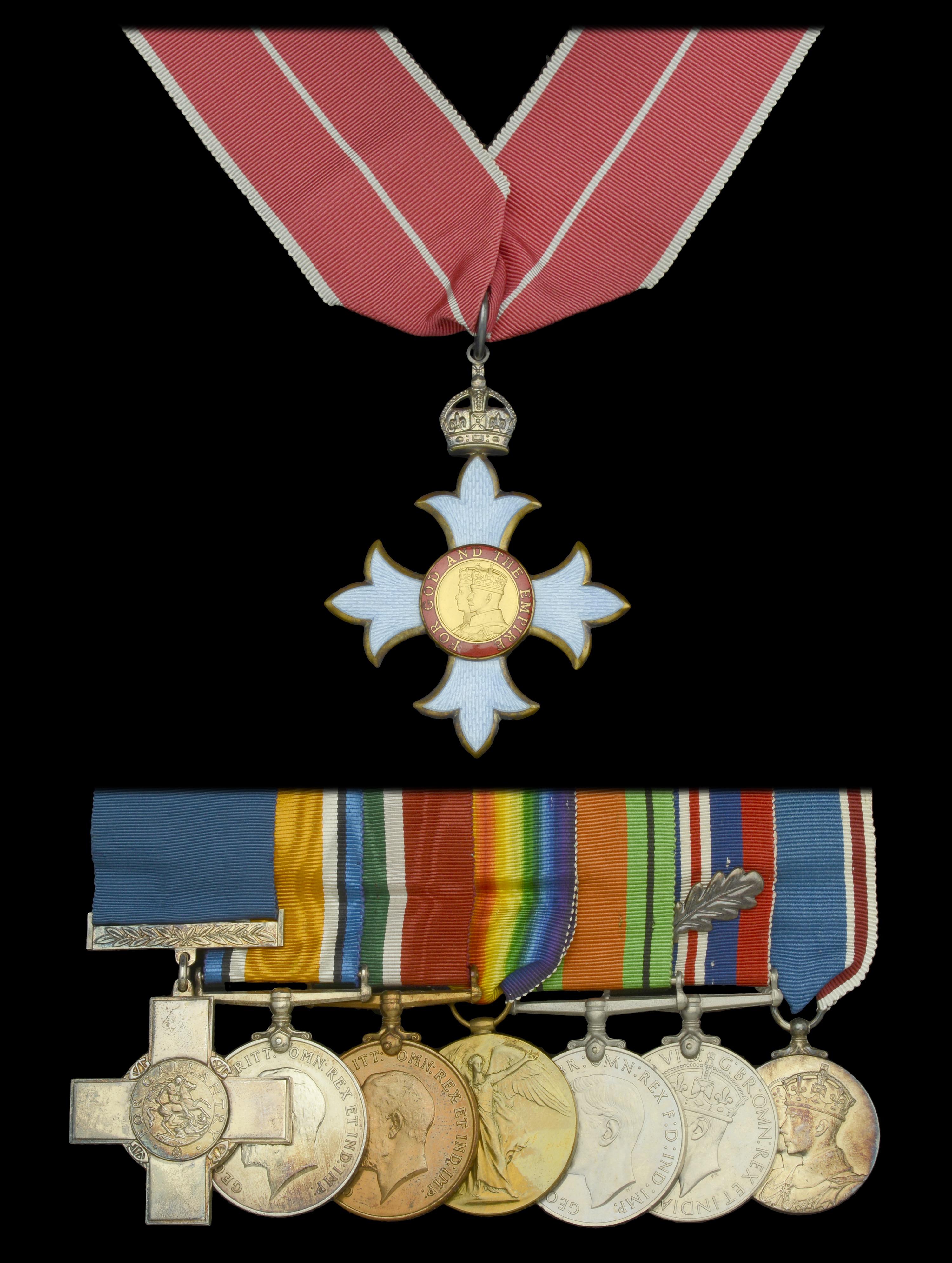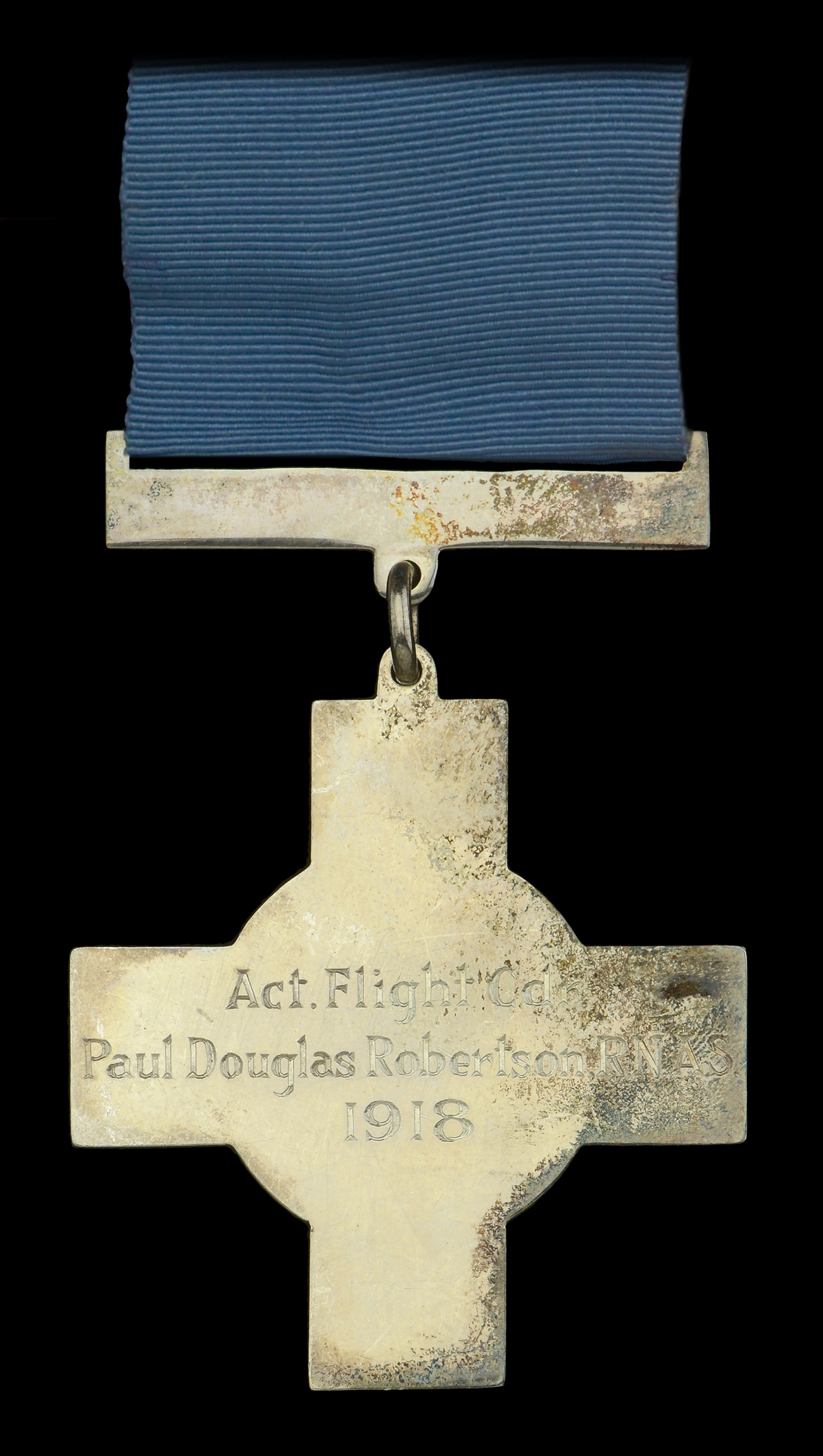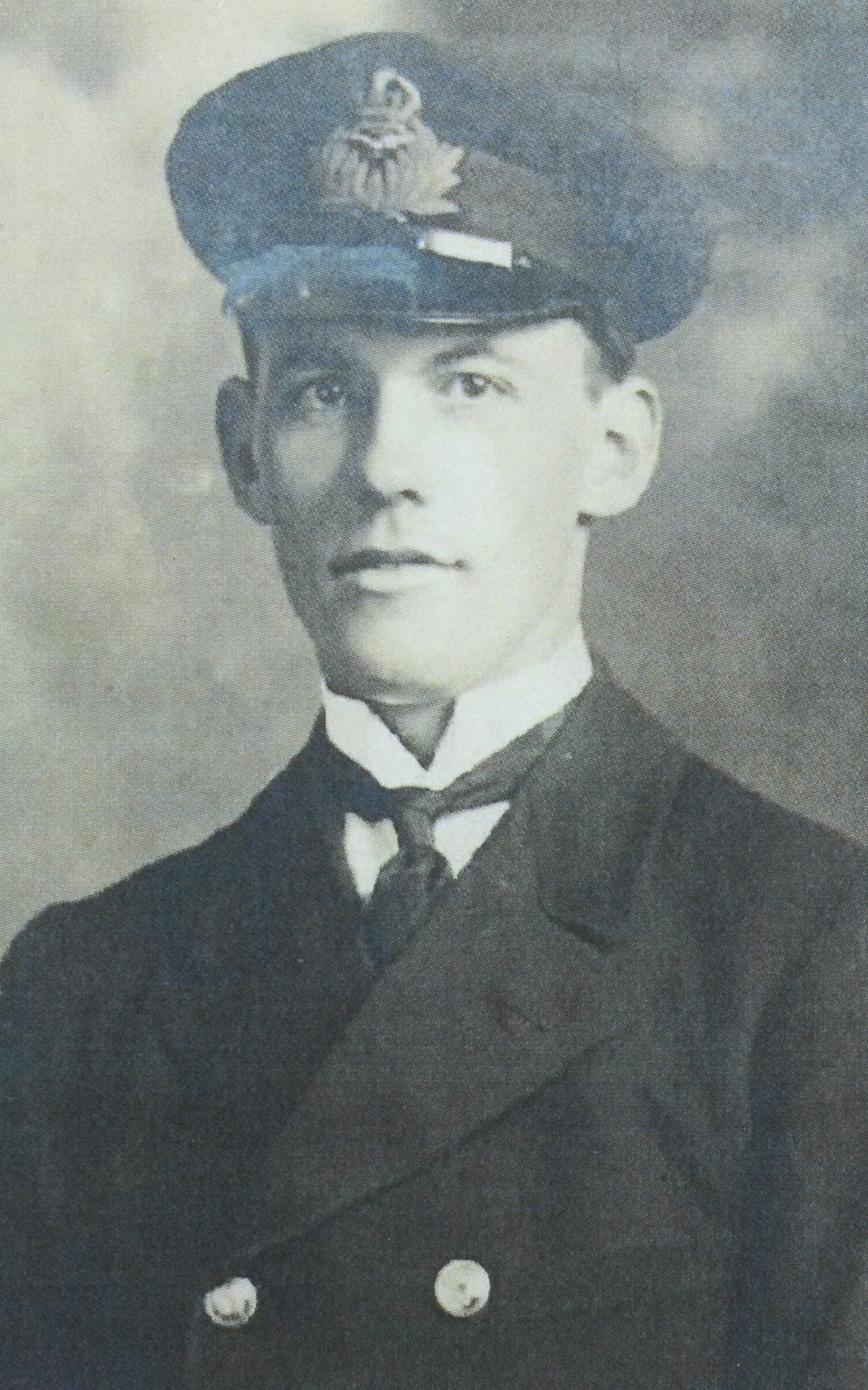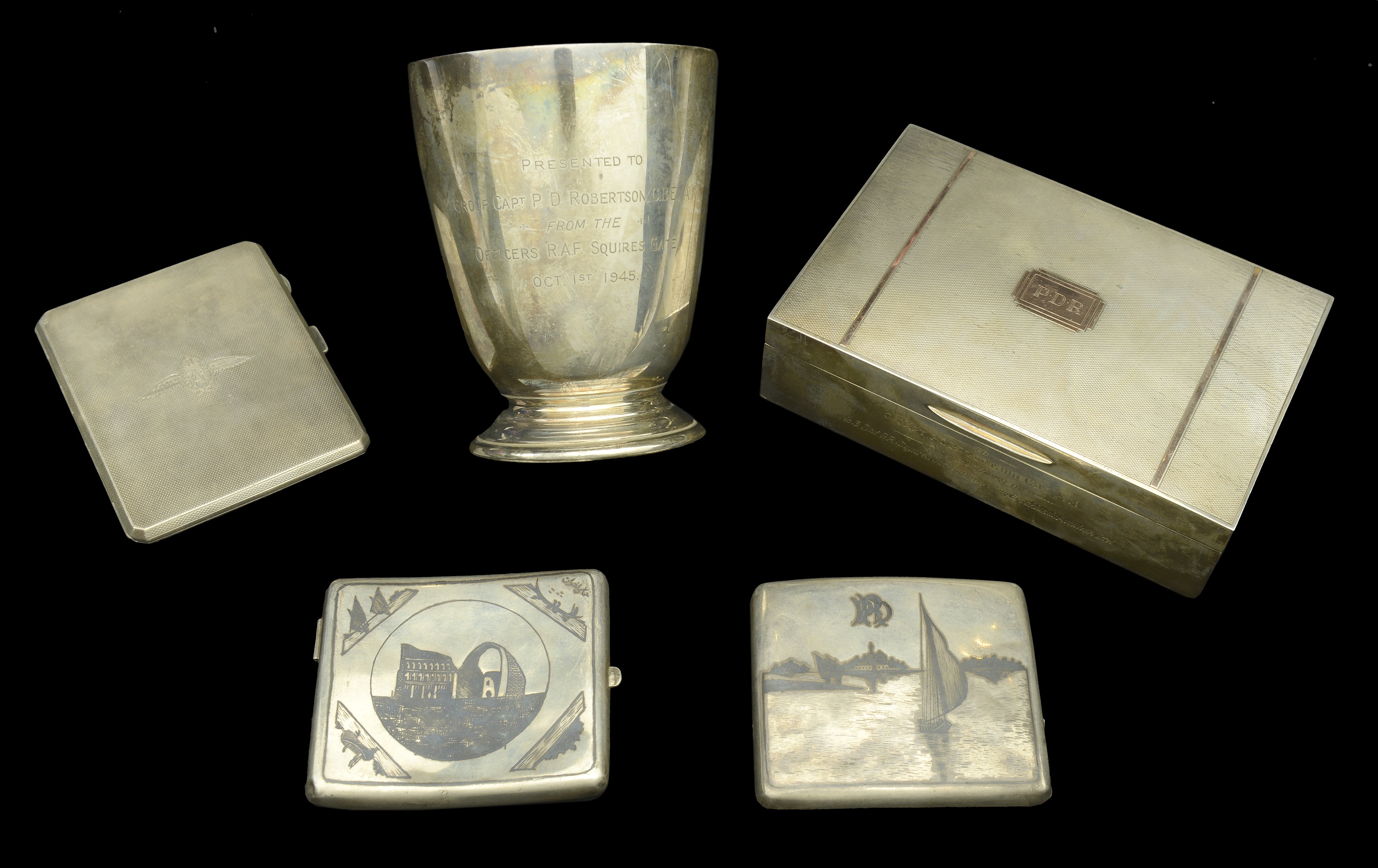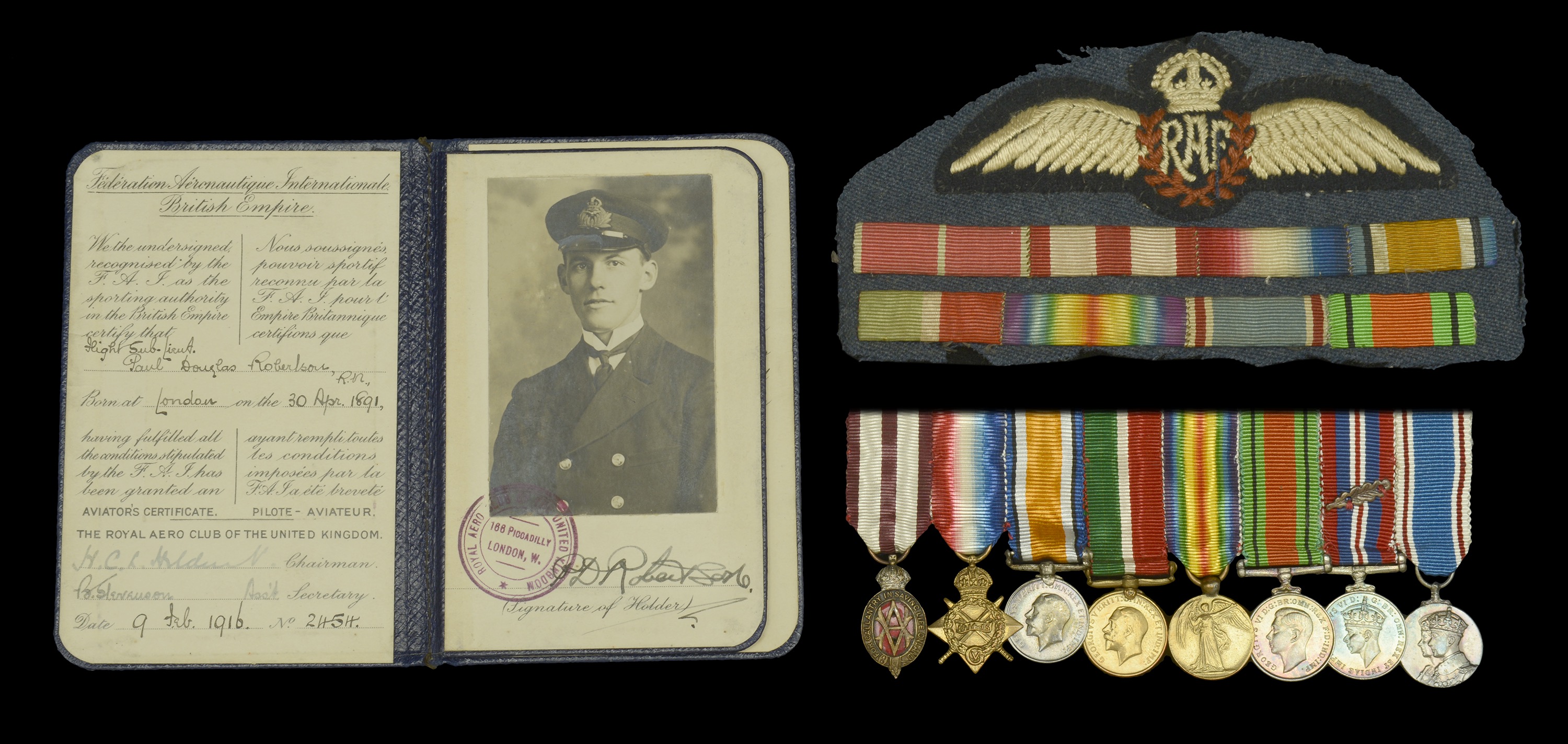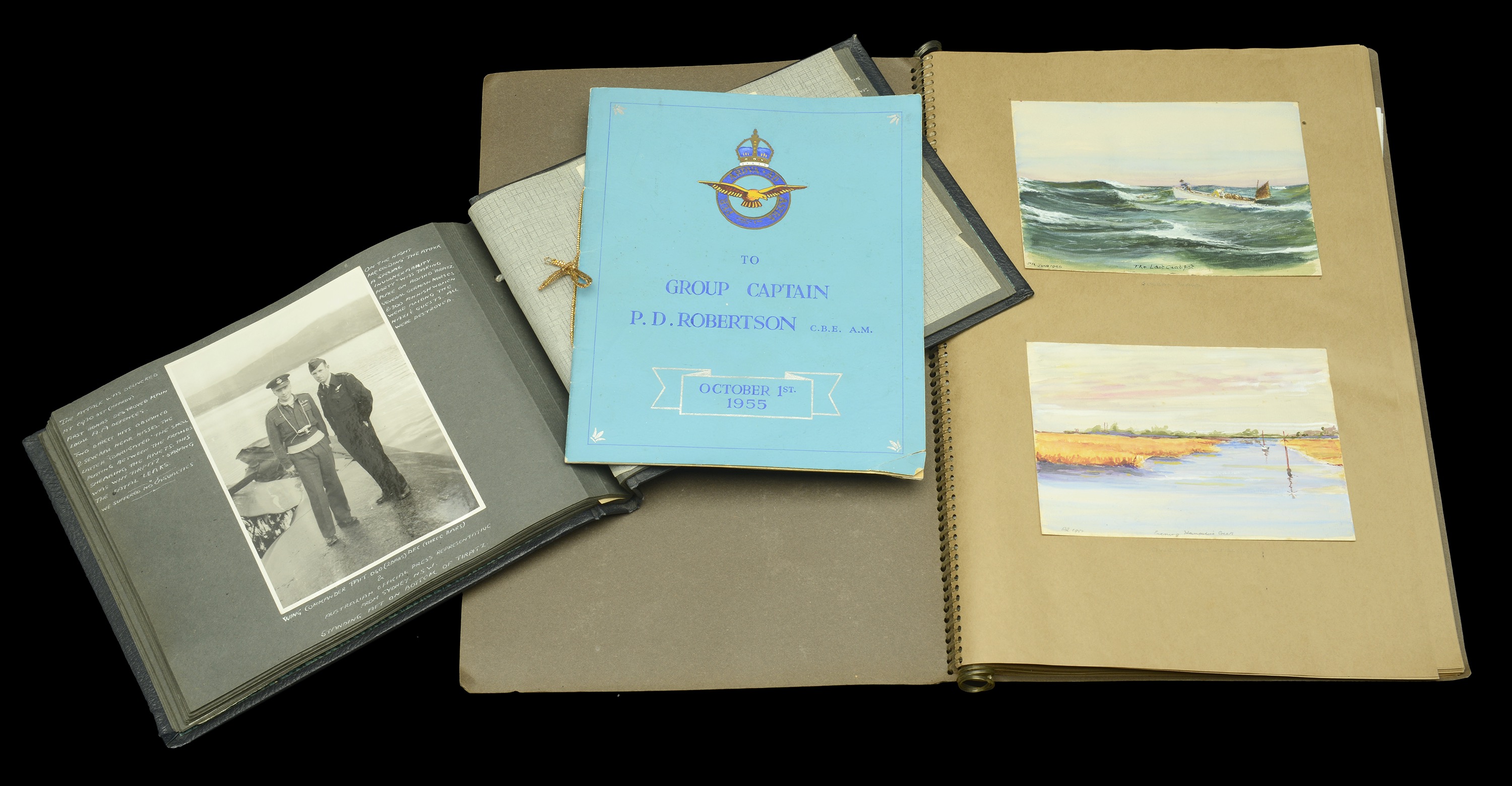A rare and unusual Great War ‘seaplane incident’ George Cross (exchange A.M.) and Second World War C.B.E. group of eight awarded to Group Captain P. D. ‘Robbie’ Robertson, Royal Air Force, late Merchant Navy and Royal Naval Air Service His heroic efforts to save his pilot from the blazing wreckage of their seaplane in February 1918 left him with such severe burns to his face, hands and legs ‘that his recovery was for some time in doubt’ The Most Excellent Order of the British Empire, C.B.E. (Military), Commander’s 2nd type neck badge, silver-gilt and enamels, with its Garrard & Co. case of issue; George Cross (Act. Flight Cdr. Paul Douglas Robertson, R.N.A.S. 1918) with its Royal Mint case of issue; British War Medal 1914-20 (Capt. P. D. Robertson. R.A.F.); Mercantile Marine War Medal 1914-18 (Paul D. Robertson); Victory Medal 1914-19 (Capt. P. D. Robertson. R.A.F.); Defence & War Medals 1939-45, with M.I.D. oak leaf; Coronation 1937, the last seven mounted for wearing, together with an earlier mounted set of related miniature dress medals (8), with the A.M. up front, generally very fine (9) £16,000-£20,000 --- Importation Duty This lot is subject to importation duty of 5% on the hammer price unless exported outside the UK --- --- Provenance: Glendining’s, November 1999. Just three members of the Royal Naval Air Service received exchange-George Crosses. A.M. London Gazette 18 June 1918: ‘The King has been pleased to award the Albert Medal to Acting Flight Commander Paul Douglas Roberston, R.N.A.S., in recognition of his gallantry in endeavouring to save life in February last. The circumstances as follows: On the 28th February 1918 a Seaplane got out of control and spun to the ground. Acting Flight Commander Robertson, the Observer, jumped from the machine just before it reached the ground and landed safely, as the ground was marshy. The Pilot, Flight Lieutenant H. C. Lemon was imprisoned in the Seaplane, which, on striking the ground, immediately burst into flames, and notwithstanding that the vicinity of the Seaplane was quickly a furnace of blazing petrol, and that heavy bombs, a number of rounds of ammunition, and the reserve petrol tank were all likely to explode, Acting Flight Commander Robertson returned and endeavoured to extricate the Pilot, and only desisted when he had been so severely burned in the face, hands and leg that his recovery was for some time in doubt. He displayed the greatest gallantry, self-sacrifice and disregard of danger in his efforts to extricate the Pilot.’ C.B.E. London Gazette 1 January 1944. Paul Douglas Robertson was born at Willesden, Middlesex on 30 April 1891, the son of a Master Mariner and Marine Superintendent, a profession that led to young Paul being educated in London, Jamaica and Australia. In August 1907, he followed his father into the merchant service, when he became an indentured apprentice to George Thompson & Co. Ltd. and he subsequently qualified for his certificates of competency as Second Mate and First Mate. But the advent of aviation and the progression of war persuaded him to change direction, and, in October 1915, he was commissioned in the Royal Naval Air Service as a Temporary Probationary Flight Sub. Lieutenant. Having then taken his aviator’s certificate (No. 2454) in a Grahame-White Biplane at R.N.A.S. Chingford on 9 February 1916, he was posted to the seaplane base at Calshot. In January 1917, he transferred to R.N.A.S. Killingholme in North Lincolnshire, from whence he would have flown patrols over the North Sea; his service record notes him as having attacked an enemy submarine on 27 June 1917, ‘results unknown.’ Then in February 1918, on being promoted to Acting Flight Commander, Robertson took command of the Hornsea Mere Sub. Station in Yorkshire. It was in this capacity that he teamed-up with Flight Lieutenant Hubert Lemon for a patrol on the 28th, their Large Seaplane taking off at 1647 hours but, when at 2,500 feet, it ‘spun to the ground and burst into flames’; his service record refers. His bravery on that occasion, in attempting to rescue the pilot from the blazing wreckage of their aircraft, led to an Admiralty recommendation for an Albert Medal in Bronze, although it is said that other members of the relevant committee considered that ‘a recommendation for the Gold Medal could have been justified.’ The extent of the burns to his face led to the loss of his left eye but he was able to attend an investiture at Buckingham Palace on 31 October 1918. Roberston obtained a regular commission as a Flight Lieutenant in the newly formed Royal Air Force and gained steady promotion in the inter-war period, being appointed a Group Captain in July 1939. His appointments in the Second World War included a tour of duty in Canada 1940-42, including service as the Operations Station Commander at R.C.A.F. Patricia Bay, Vancouver Island, B.C., and, on his return to the U.K., command of the R.A.F. Station, Squires Gate, near Blackpool, for which he was awarded the C.B.E. He had earlier been mentioned in despatches (London Gazette 2 June 1943, refers). Placed on the Retired List in December 1945, Robertson settled in Cornwall, and he exchanged his Albert Medal for the George Cross in 1972. Following the death of his wife, he emigrated to Auckland, New Zealand, where he died in August 1975. Sold with a quantity of original documentation, including his Federation Aeronautique Internationale (British Empire) Aviator’s Certificate (No. 2454), with portrait photograph, dated 9 February 1916; a photograph album of mainly Second World War interest, including career notes, images from the recipient’s visit to the wreck of the Tirpitz in 1945, and pasted down mention in despatches certificate, dated 2 June 1943; a presentation programme for the 10th reunion of old Squire’s Gate personnel, October 1955, and an album containing numerous watercolour pictures by the recipient, including still life and nautical subject matter. Also sold with a quantity of presentation pieces, including a silver tankard, with hallmarks for Sheffield 1942 and engraved inscription, ‘Presented to Group Capt. P. D. Robertson C.B.E., A.M. from the Officers R.A.F. Squires Gate Oct 1st 1945’; a silver cigarette box, with gold inlay and initials ‘PDR’ to lid, hallmarks for Birmingham 1953 and engraved side inscription, ‘To G. Capt. P. D. Roberston, C.B.E., A.M., from members of No. 3 S. of G.S. (Squires Gate) incorporating Brooklands Aviation Ltd.’; a silver cigarette case, with engraved R.A.F. Wings to front of case, gilt interior, hallmarks for Birmingham 1940; a silver vests case, hallmarks for Birmingham 1923, with engraved initials ‘PDR’ to front of case; a damaged metal cigarette case with engraved interior inscription, ‘A small token of my great respect for my master F./Lt. P. D. Robertson, October 13th 1927’; together with a cut out section of uniform bearing his R.A.F. Wings and medal ribands, and a small quantity of buttons and studs. Please note that this lot is not suitable for shipping, but can be hand delivered within mainland Britain by prior arrangement.
















